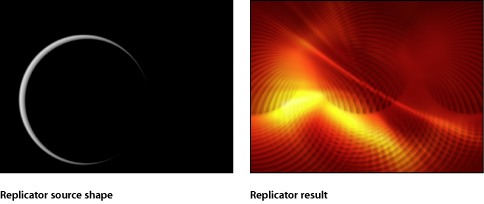Replicator Concepts
The replicator in Motion builds patterns of repeating elements with minimum effort. The elements of the patterns can consist of video, still images, shapes, text, or any other type of layer in a Motion project. For example, with very few clicks of your mouse you can create spinning loops based on a basic shape.

Replicator parameters can be keyframed to change a pattern’s dynamics over time. For example, you can create a wave of dots that follow one another across the screen by keyframing the replicator’s Offset parameter.

You can add behaviors to the replicator or its cells to create even more varied effects (simulation behaviors can be especially effective). Behaviors applied to a replicator or a cell can be applied to each element of the pattern. This lets you achieve almost limitless variation and complexity that would take hours to animate using keyframes. You can also apply a behavior, such as Vortex, to another object in your project (an object that is not part of the replicator pattern), and have the pattern elements circumnavigate that object.
A special behavior called Sequence Replicator allows you to choreograph the parameters of your onscreen elements (their position, scale, and opacity, for example) in a sequential animation. For more information, see Using the Sequence Replicator Behavior.
Replicators take advantage of Motion’s 3D capabilities. Some replicator shapes are inherently 3D, and others can have points that exist in 3D space. Additionally, behaviors applied to a replicator can pull pattern elements out of a plane. For more information, see Using Replicators in 3D Space.